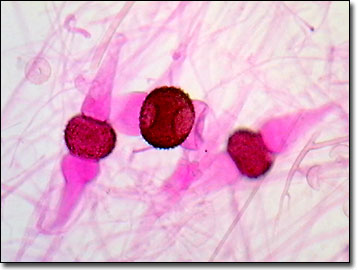Brightfield Digital Image Gallery
Rhizopus Conjugation
As the bane of fruit growers and produce managers, but the recipient of high praise from Japanese chefs and vegetarians worldwide, the fungal genus Rhizopus represents a series of contradictions and wonders. Named because of their rhizome-like creeping stolons, these fungal colonies in the division Zygomycetes (or Zygomycota) can spread rapidly by airborne spores or via the root-like rhizoids.

One species, Rhizopus oligosporous, is capable of transforming cooked soybeans into the highly regarded tempeh. The mycelium of the mold grows through the soybean paste holding it together to give tempeh its characteristic chewy texture, while fermentation gives it a distinctive flavor. In Japan and other Southeast Asian countries, tempeh is commonly used as a meat substitute and can be deep-fried, sautéed, baked, or steamed.
Rhizopus rot is a soft rot of harvested or over-ripe stone fruits, such as peaches, nectarines, sweet cherries, and plums. Mold species belonging to the genus Rhizopus cause the rot, which initially appears on the fruit as a fuzzy white mass, called the mycelium. The fungus produces enzymes that deteriorate the tissue, holding the skin to the flesh of the fruit. Later, the fruit turns dark gray to black as the fungus begins to develop spherical sporangia. The sporangia can reproduce asexually via mitospores (or sporangiospores, diploid or 2N), or sexually. Each sporangium, the fruiting structure, produces desiccation- and cold-resistant thick-walled zygospores (diploid or 2N) via conjugation of the isogametes (haploid or N) in the gametangia when growing conditions are not favorable. Once released into the air, the spores can infect injured fruit, in both orchards and on kitchen countertops. After infecting a host, such as a slice of bread, the mold (R. nigricans) will form mature zygospores within four or five days.
R. stolonifer is a species that commonly affects damaged fruit in household kitchens, although uninjured fruits are not susceptible to the disease. However, fungal spores can remain dormant until the fruit is harvested. After the fruit ripens and is harvested, the fungus that is already present on the fruit skin is ready to germinate and grow as the fruit ages and the integrity of the skin deteriorates. This saprophytic fungus can also infest many crops and cause root rot when there is a combination of too much soil moisture and damage from insect pests. When the leaves of sugar beets are chewed by the armyworm (the larva of the moth, Pseudaletia unipuncta), the damage creates a point of entry for Rhizopus spores that invade the plant. The fungus grows throughout the plant, ultimately rotting the root.
Contributing Authors
Cynthia D. Kelly, Thomas J. Fellers and Michael W. Davidson - National High Magnetic Field Laboratory, 1800 East Paul Dirac Dr., The Florida State University, Tallahassee, Florida, 32310.
BACK TO THE BRIGHTFIELD IMAGE GALLERY
BACK TO THE DIGITAL IMAGE GALLERIES
Questions or comments? Send us an email.
© 1995-2025 by Michael W. Davidson and The Florida State University. All Rights Reserved. No images, graphics, software, scripts, or applets may be reproduced or used in any manner without permission from the copyright holders. Use of this website means you agree to all of the Legal Terms and Conditions set forth by the owners.
This website is maintained by our
Graphics & Web Programming Team
in collaboration with Optical Microscopy at the
National High Magnetic Field Laboratory.
Last Modification Friday, Nov 13, 2015 at 01:19 PM
Access Count Since September 17, 2002: 34755
Visit the website of our partner in introductory microscopy education:
|
|
